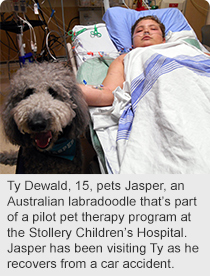
May 6, 2015
Story by Kerri Robins; photo by Melody Duncan
Leave it to man’s best friend to make a ‘paws-itive’ difference for sick kids at the Stollery Children’s Hospital.
Hounds have become enthusiastic healers as they walk the Stollery halls to visit with young patients as part of a one-year pet therapy pilot program launched last September.
Fifteen-year-old Ty Dewald is one of the youngsters seeing benefits from of the program. A February car accident in his hometown of Czar, 250 km southeast of Edmonton, turned the lives of Ty and his family inside-out.
 But shortly after his admission to the Stollery with multiple pelvis fractures, Ty soon befriended Jasper, the Australian labradoodle, who has proven a constant companion.
But shortly after his admission to the Stollery with multiple pelvis fractures, Ty soon befriended Jasper, the Australian labradoodle, who has proven a constant companion.
“Ty misses our black lab, Beau, so Jasper is a nice substitute for now while Ty recovers,” says mom Melanie Dewald. “Ty takes every chance he can get to see the dog — he never refuses a visit.”
Funded through a private donation to the Stollery Children’s Hospital Foundation — from Dr. Ray Muzyka, a family physician, and his wife, Leona De Boer — the dogs deliver tender-loving care.
The goal of the program is to improve the emotional and physical well-being of pediatric patients. The dogs often tag along with kids to X-ray or testing procedures, and allow the child to brush or pet them, or can simply sit beside the child’s bed.
Certified through the non-profit Pet Therapy Society of Northern Alberta, the dogs undergo special practicum training prior to working at the hospital. They must be two years old or older, good-natured, calm, gentle, hypoallergenic and be able to respond to basic commands and enjoy people. There is no size or breed restriction.
Stressing the program’s benefits is Melody Duncan, a Child Life Specialist at the Stollery, who’s worked with the pet therapy program since its inception.
“These dogs really put a smile on kids’ faces and give them a sense of normalcy through the unconditional love pets are so good at,” says Duncan.
“The dogs put our patients at ease, not only during the stress of tests and procedures, but help them forget their struggles for a time.”
Therapy sessions with each patient last about 30 minutes. Each dog’s working shift is 90 minutes. There are currently three dogs in the program that runs Tuesdays, Thursdays and Fridays.
Duncan says patients must be referred to take part in the pet therapy program.
“The patient must be referred because of a specific condition, for example, mobility problems, needing help to improve moods, dealing with a medical procedure or simply the need for companionship,” she says. “Since we’ve started the pilot, we’ve had 68 inpatient and four outpatient visits by the dogs.
“We’ve had 100 per cent positive feedback on the program. The dogs are a great alternative to traditional treatment and help our kids heal in ways that some medicines just can’t do.”
Mike House, president and CEO of the Stollery Children’s Hospital Foundation, says he’s happy with the program and the difference it’s making.
“Wonderful things happen when donors combine their passion with the betterment of children’s health,” he adds.
“We are fortunate to have donors like Ray and Leona, dog-lovers who gave generously to get the pet therapy program at the Stollery underway. By continually investing in the best people and programs, our donors are the difference when it comes to keeping the Stollery family-centred and world-class.”
For Ty, his mom says his prognosis is good.
“He’s now at the Glenrose Rehabilitation Hospital working on getting his legs back in shape so he can hit the ice for hockey next year,” says Dewald.
For more information, visit stollerykids.com